Is Arkansas still capable of going 8-4 or better, or will they end this season fighting just to make a bowl? We’re going to learn a lot on Saturday. The Hogs are up against it, on the road and likely without their star quarterback.
This is our longest matchup analysis ever, and we’ll look at all the following topics:
- Arkansas’ issues creating big plays
- Cade Fortin: his background, his career, and how he looked against Alabama
- Mississippi State’s 3-3-5 defense
- The Mike Leach Air Raid, and how Arkansas might stop it
Meet the Bulldogs
Confused by any of the advanced stats you see here? Be sure to check out the glossary.

Consistency and Momentum metrics will go in use starting next week. The Hogs have played a much tougher schedule, but the Arkansas defense is the main thing separating these two teams.
Model pick: Mississippi State 43, Arkansas 32. The total on this game from Vegas is somehow just 61.5, so our model is hammering the over.
Scouting Report
Mississippi State’s Air Raid offense is fine being one-dimensional. The Bulldogs are extremely efficient, happy to take short, safe throws to move the ball. They are very good in the red zone, but turnovers – particularly fumbles – are a bugaboo.
The Bulldog defense is hard to mount long drives against, and is good at intercepting passes. They are subpar against the run and vulnerable to big plays.
Names to Know
- Will Rogers. The State QB threw for 417 yards in Fayetteville last year. Given the state of Arkansas’ secondary, he might be primed to do it again.
- Rara Thomas. He caught two touchdowns against the Hogs last year and has now taken over as the top option in Starkville. He had 5 catches for 134 yards and a score against Texas A&M. There isn’t a single guy you can focus on, but he’s probably the most dangerous in the State passing attack.
- Jett Johnson. State’s leading tackler is a very reactionary linebacker. Almost all of his tackles occur well past the line of scrimmage. If he makes clean tackles, then State will contain the run. But if Hog ballcarriers can break free from or at least drag him for a couple yards every time, the Bulldog defense will be in some trouble.
When Arkansas has the ball
Given the matchup on the other side, the Razorback offense really needs a good game.

Mississippi State’s defense is the exact opposite of Texas A&M’s. The Bulldogs break up long drives, force turnovers, and get off the field on third down. They are very vulnerable to big plays, so this is a very ripe opportunity for the Hogs to finally break through with some big plays on offense.
Where are the big passing plays?
Consider this, Arkansas’ offense last year versus this year:

That’s pretty consistent. What’s not consistent is how the Hogs are doing it. The 2021 offense ranked 21st, 20th, and 15th in total, rushing, and passing explosiveness. This year’s team is just 83rd, 60th, and 45th. This year’s team is much more efficient, but the big plays have dried up.
Part of it is the run game, which has jumped to 11th in rushing success rate in a change that is probably to the offense’s benefit. But the passing game explosiveness being lost isn’t ideal, as big plays are one of the major factors in determining who wins games.
There are several ways to generate big passes, but plays designed to create huge gains – “shot” passes – are a mainstay of the old Art Briles offense that Kendal still runs in Fayetteville. You have “solo shots”, where a single receiver is targeted up the sideline, like a fade route, and “divide” concepts, where a slot receiver has a deep choice based on how the safety covers him. These require the quarterback and receiver to be on the same page.
Looking at data from SEC Stat Cat, the Hogs have attempted 13 of these shot passes through five games (2.6 per game). As we’ll see below, Cade Fortin had three of them on Saturday. Jefferson’s 10 shot passes have yielded just three successes (30%, and 0.6 per game). In 2021, Arkansas dialed up 32 shot passes (2.5 per game). Ultimately, 18 were successful (56%, and 1.3 per game). The Hogs are calling the same number of shots, but they are only succeeding on them half as often.
There are a few issues behind this:
- Drops. The Hogs have the third-highest drop rate in the SEC this year. Not great. Landers dropped a shot play that probably would have been a touchdown against South Carolina.
- Checkdowns. Jefferson is checking down more often. After just 11 checkdowns last season (0.8 per game), he’s already at seven this year (1.4 per game).
- Accuracy. If Jefferson looks less accurate this year, he is. His overall accuracy has declined from 64% to 59%, while his depth-adjusted accuracy is down from 52% (2nd-best in SEC) to 44% (8th-best).
All three of these things add up to one simple conclusion: while Arkansas’ offense remains statistically good, it is really making life difficult for itself. This has been especially true against good defenses over the last two weeks. The Hogs had 27 first downs against Alabama and, outside of a drive that started at the 3, had just 19 points. Right now, the Hogs’ running game spends 60 minutes accumulating chips at the poker table, but big passing plays are how you cash out on that success.
As Arkansas tries to figure out how to solve this, now there’s a new issue for this week.
Cade Fortin time?
Jefferson’s status is unknown for Saturday, but evidence is mounting that he will not play after hitting his head against Alabama.
Cade Fortin will likely get the start for the Hogs, but expect Malik Hornsby to have a role. We’ll get a good look at how creative Briles can be.
Fortin’s background
Fortin’s career stats entering this season aren’t great: 61 of 121 (50.4%) for 610 yards, a touchdown, and three interceptions. He also had 27 carries for 152 yards and two touchdowns. Before you judge the numbers too much, consider that those stats were put up on teams that went 2-9, 1-8, and 2-10. They all had problems that extended beyond him.
Fortin was a high 3-star recruit out of high school and went to North Carolina, where he stumbled into Larry Fedora’s final season. He stepped in during injuries and blowouts but his only start came in the season finale against archrival NC State, where he played very well, throwing for 276 yards and a touchdown while adding a rushing touchdown. The Tar Heels pushed 9-win NC State into overtime before falling, 34-28.
In line to start in 2019, Fortin’s fortunes took a turn when new coach Mack Brown landed blue-chip recruit Sam Howell. Fortin decided to transfer after it become clear Howell would be the starter in spring ball. He ended up at South Florida, where he hoped to play for Charlie Strong. Unfortunately, that didn’t work out either, as Strong was fired after going 4-8 in 2019 while Fortin sat out. The Bulls brought in Jeff Scott, who has been a disaster. Fortin attempted just eight passes on the 2020 team that went 1-8, but was named team starter entering the 2021 season. It did not go well: he was 7 of 20 for 41 yards in a 45-0 loss to NC State to open the season, and then was benched in the Swamp the following week after completing 12 of 18 passes for 91 yards and a pick. He made only a couple of appearances after that.
After the 2021 season, Scott hired Chad Morris as an offensive analyst (always a good idea) and brought in Earle native Gerry Bohanon to quarterback the offense. Fortin transferred out. Bohanon has struggled this year, and Scott is basically guaranteed to get a pink slip after the season due to his 4-22 record in Tampa.
Fortin’s game
Kendal Briles called Fortin “a steal”, and a closer look at his game suggests that he does indeed fit well into what Arkansas is wanting to do.
Coming out of high school, his big strength was the deep ball. He throws over-the-shoulder deep passes with good accuracy:
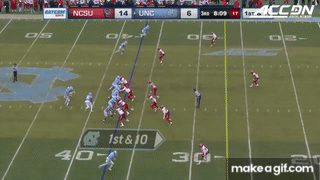
He throws best from the pocket, where his footwork is fantastic and his throws are aesthetically pleasing. He gets excellent drive on shorter throws, throwing slants, curls, and hitches with great precision. He can fit the ball into tight windows.
He does not throw well on the run, and his touch passes are sometimes lacking.
As he runner, he’s not very fast but he has tremendous acceleration and vision. He didn’t scramble much at North Carolina, but was absolutely good enough as a runner to punish the defense on read plays:
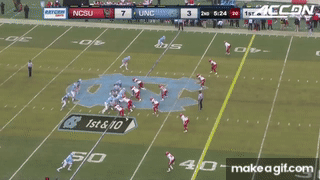
This is especially beneficial near the goal line or in short yardage, where he has enough acceleration to find holes:
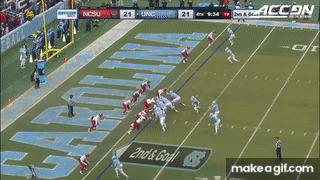
Had he stayed at North Carolina (and the Tar Heels not signed Howell), he probably would have been a perfectly competent – maybe even good – ACC quarterback.
At USF, however, he had several issues. He’s best when throwing with his feet set, but he spent most his time in Tampa running for his life. Additionally, his main weakness was exposed: staring down receivers. It’s a common problem for quarterbacks that struggle to transfer their game to higher levels of football, but consider that USF coach Jeff Scott replaced Chad Morris as Clemson’s OC. The Morris/Scott/Clemson offense has struggled outside of Clemson for one main reason: the pass progressions require the quarterback to read both sides of the field, but none of these coaches can find (and teach) a guy to actually read both sides of the field. Both Ben Hicks and Nick Starkel were undone by the fact that they were consistently unable to get through the progressions Morris was asking them to, so they either stared down their targets or took sacks while trying to find others.
So more than anything else, Fortin was, ultimately, held back by his choice of schools. He went to a team that cratered to 2-9 in his freshman year, transferred to a collapsing South Florida program, and was then unlucky that USF made a bad hire after he was there.
Fortin vs Alabama
Clips from a single game in 2018 will only get you so far. We saw a good bit of Fortin against Alabama last week in the fourth quarter.
There’s not much to take away from his first snap, as it came in a tough situation: second-and-goal after Jefferson was hurt. The Hogs can’t afford to waste a play, so they call a fade to Matt Landers:
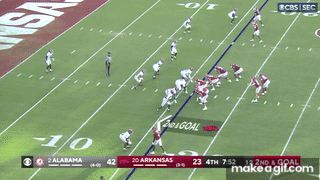
This is not an accurate throw, but I don’t think there was a way to turn this into anything, as Kool-Aid McKinstry had great coverage. Landers does well to knock the ball away and prevent an interception.
After that, Fortin commanded two more drives: a three-and-out, and then the nine-play, 46-yard drive that ended in the Tide red zone.
On the first drive, the Hogs open with an RPO: an outside zone read attached to a swing pass. If the read defender crashes in on the run, Fortin can keep or swing the ball out to Jadon Haselwood. Instead, he makes the correct read and hands off to AJ Green:
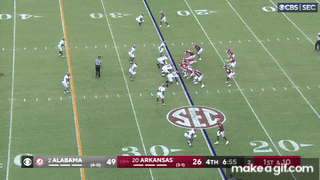
On second down, the Hogs empty the backfield and run a “spacing” concept, where all five receivers settle down in underneath zones. Fortin looks for Landers on an outside hitch against excellent cornerback Eli Ricks:
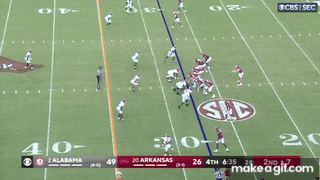
Once again, the coverage here is too good, so there wasn’t much Fortin could do. His footwork is good and the throw is crisp and accurate. Landers probably could have used his body better and made this catch.
On 3rd-and-7, the Hogs try a solo shot to Jaedon Wilson:
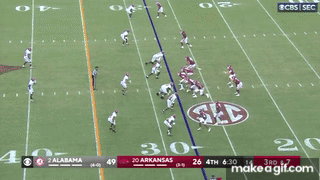
I’m not sure what happened here. This is a timing throw made to a spot, but Wilson clearly had issues on release. There may have been a miscommunication, or he may have just been locked up by the cornerback.
The Hogs get the ball back and open the next series with a 2-yard run by Rashod Dubinion on the same OZ RPO as above. On second down, they take another shot, this time targeting Ketron Jackson:
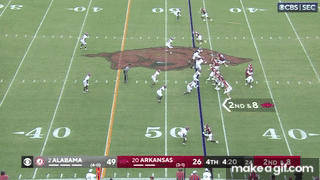
This is a much better play. Jackson does a great job of getting separation and even getting an arm out to make the catch. The ball is slightly overthrown, but this is a near-miss. As we saw above in his UNC days, Fortin attempted a lot of deep shots up the sideline in the Fedora offense, so it would not surprise me if the Hogs take some 1-on-1 shots when Mississippi State focuses their safeties on the run.
On 3rd-and-8, the Hogs empty the backfield and run some high-low combos on each side. Dubinion comes open early on a slant (follow Fortin’s eyes and note the staring down receivers bit from earlier), but Fortin flees the backfield a little prematurely and uses his mobility to get the first down:
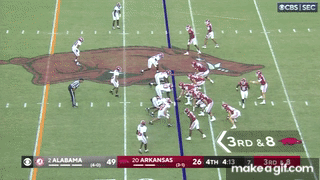
At this point, Fortin still doesn’t have a completion, but he’ll hit four of his next six attempts to close the game. That starts with this RPO, an “iso” run attached to a slant read on the safety. When the safety comes down to fill the hole, Fortin pulls and throws a nice strike to Landers:
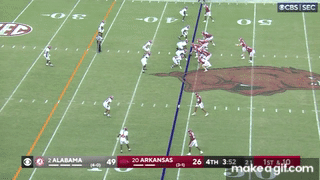
The next play is another nice throw. The Hogs put a spread bunch to the right, setting up a quick screen for Dubinion if the Tide don’t appropriately cover it. They do, so Haselwood has leverage on a backside slant:
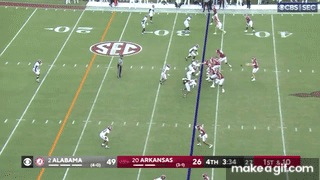
This is a good throw, but it’s an even better play by Haselwood, who felt out the ball and the defender and used the throw being slightly behind him to spin into a bigger gain.
The next two plays are incomplete passes: on the first one, Fortin dropped the snap and had to throw the ball away. On 2nd-and-10, the Hogs got one more dose of classic SEC Officiating: the Tide jumped offsides, so Ricky Stromberg quick-snapped it, letting Fortin take a shot to the end zone on a free play. Except there was no free play: the obvious offsides was not flagged and the incomplete pass stood. Whatever.
On 3rd-and-10, the Hogs run a “drive” concept out of a trips look. Fortin finds the underneath shallow cross with a good throw:
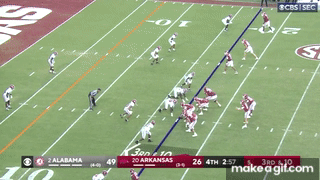
The only problem with this play was the personnel: why is blocking specialist Nathan Bax lined up as a receiver for a shallow cross? A faster receiver wouldn’t have gotten the first down, but they could have gotten a couple more yards here.
The final play – 4th-and-5 – was a “bench” concept:
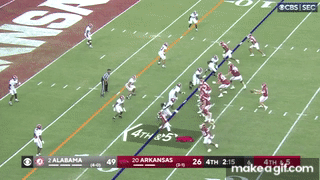
Fortin does have a bit of a slow dropback, and an earlier throw might have given his receiver more time. Still, the throw was accurate, and Haselwood just tried to do too much here. Lowering his shoulder probably gets the first down.
What can we expect on Saturday?
The Cade Fortin we saw for 13 plays in the fourth quarter against Alabama looked like the same guy in that 2018 UNC-NC State game. The upside is definitely there: a quick, crisp delivery that allows him to fit the ball into tight windows. He’ll throw curls, slants, and hitches with excellent precision and very good drive. He’s very accurate when allowed to get his feet set and make simple reads. He can punish cheating safeties with shots up the sideline, where he gives his receiver a chance to make the catch more often than not. And he’s got good acceleration and vision to be a threat on read plays or as a scrambler.
As we’ll see below, Mississippi State’s defense is not disruptive and is vulnerable to big plays. That’s a pretty good setup for a deep ball passer who works best with his feet set. The Hogs will start with the power run game, take frequent deep shots to pick on Bulldog safeties trying to help against the run, and use RPOs to put State’s edge defenders in conflict. The downside will be interceptions, as Fortin is far more likely than Jefferson to put the ball in harm’s way. If Fortin struggles, then we’ll probably see what Hornsby can do as a complement. Again, this is a good game to see just how creative Kendal Briles is.

The only thing missing from State’s anti-efficiency defense is that havoc rate, sitting at 91st. The Bulldogs do a good job of knocking opponents off-schedule, but they don’t generate enough negative plays. They are vulnerable against early down running (99th) and early down big plays (92nd). That’s pretty much exactly what Arkansas wants to do, so there’s a winnable matchup here.
Arkansas’ 72% run rate on standard downs is probably too high. The Hogs aren’t going to create big plays without throwing more. As we saw above, Fortin has the skillset to create big plays with his arm on early downs, but even if Jefferson is back, the Hogs have to get more creative with the early downs passing game. As we discussed earlier this week, Rocket Sanders needs more targets down the field. He’s a good receiver who will almost always have a friendly matchup:
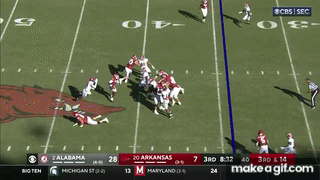
Mississippi State’s defense, under Zach Arnett in his third season, runs a base 3-3-5. The Bulldogs will always have three down linemen. They obviously cannot get much pressure with a three-man rush, so they typically bring at least one defender from the linebackers or secondary on a rush.
On this play, for example, the Bulldogs are in an “under” front, where the line has shifted to the weak side of the formation and the strongside linebacker steps in:
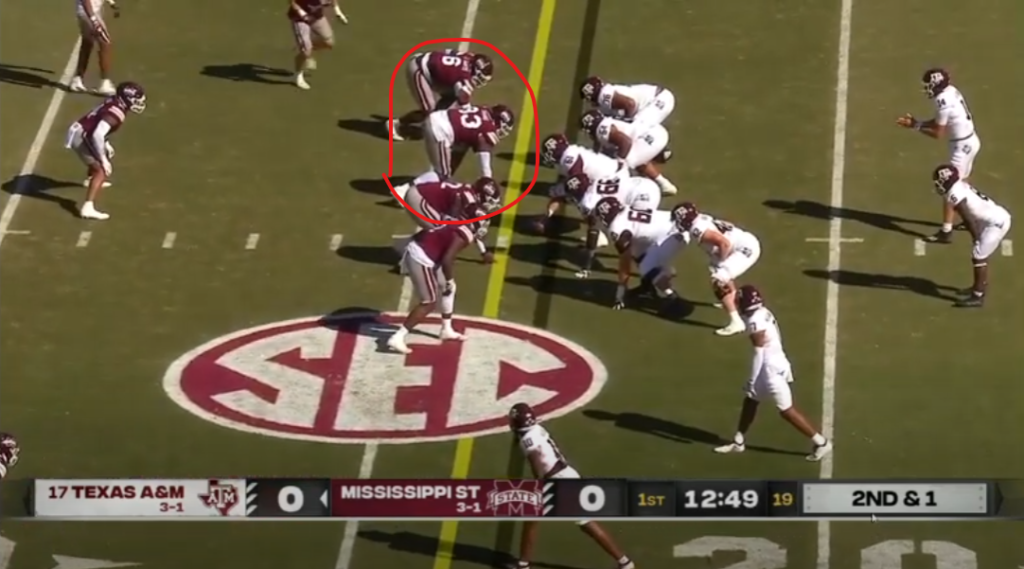
One reason they don’t create much havoc? They like to crowd guys at the second level to confuse the offense:
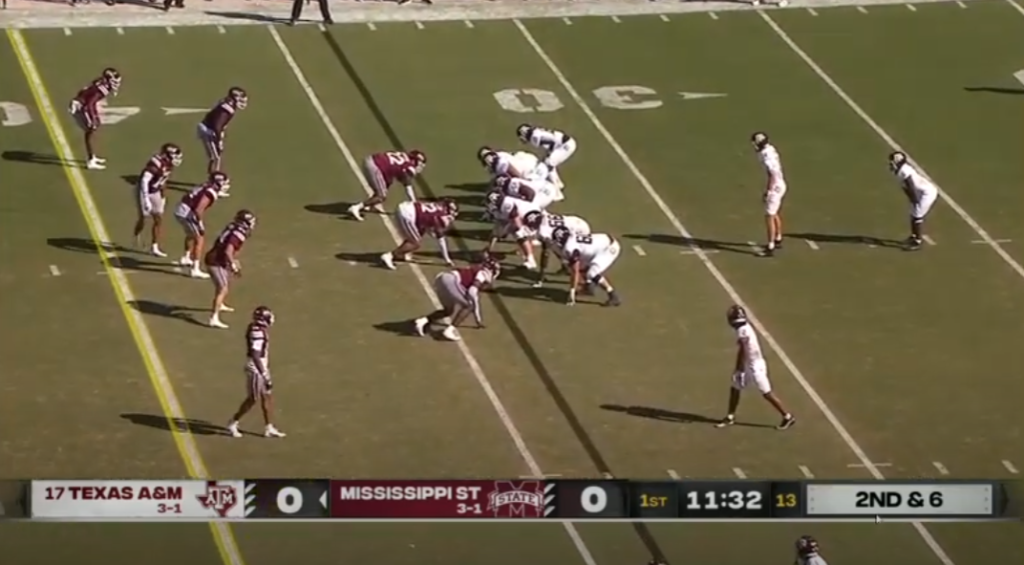
That’s six guys all eight or nine yards from the line of scrimmage.
That look didn’t end up working out, as Mississippi State’s group of dudes all got dragged into the strongside and were not ready for the cutback by Devon Achane:
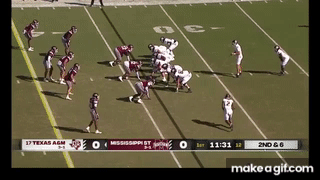
State’s defense is letting opposing run games get blockers downhill against them too often this season.

The red on State’s side tells the story: not many sacks, not many run stuffs, too many big runs allowed. The Hogs should have success grinding this thing on the ground, controlling the clock, winning field position, and keeping the defense fresh. And if the truly big runs are going to come, this might be the game for it.
The pass defense is held up by its six interceptions. Arizona’s Jayden de Laura tossed three, and A&M’s Haynes King – who will absolutely throw you the football if you ask nicely – tossed two despite playing less than one half.
I expect State to blitz a decent amount. That’s usually how teams play the Hogs. It is true for Jefferson, but it will also be true for Fortin, who will do his best work with a clean pocket. Arkansas’ line did a decent job of holding up against Alabama’s dangerous pass rush; State’s is much weaker.
When Mississippi State has the ball
It’s Mike Leach week, so it’s Air Raid week. The Hogs showed the nation the blueprint for shutting down Leach’s SEC teams (hint: it’s about the same as it was during his Big 12 and Pac-12 days) with the rush-3, drop-8 zone strategy that drew Barry Odom a ton of acclaim as Arkansas’ defensive coordinator in the Hogs’ 21-14 win in Starkville in 2020. But things have changed since then. The Bulldogs have gotten better at solving that defense, while the Hogs are, for the second straight year, facing State without Jalen Catalon, the engine that made that Dime defense go.

The Air Raid mostly dinks and dunks, ranking 11th in efficiency but only 87th in explosiveness. The Bulldogs are good at finishing drives, but turnovers are a bugaboo: they’ve only thrown three picks, but five fumbles have been lost and at least three others were recovered by the Bulldogs.
Turnovers are basically all Arkansas can do well at this point, as most of the havoc the Hogs create ends up for nothing as opponents get it all back on third-and-long.

Leach is slipping. There are 131 teams in the FBS, so his Bulldogs are merely next-to-last in run rate on standard downs and passing downs. Washington State actually throws more often on standard downs, and Iowa State more often on passing downs.
Meanwhile, Barry Odom’s effort to remake the Arkansas defense into a more aggressive, attacking unit continues along. The Hogs might be closer than it appears: the Razorbacks are now quite good at knocking opponents off-schedule (12th) and creating defensive havoc (18th). When opponents try and counter by being aggressive with standard downs passing, the Hogs can foil that too (16th). However, it has all been for naught because of the Razorbacks’ disastrous passing downs defense. The Hogs are horrific on third down (123rd) and successful plays against the Razorbacks are often for huge gains.

State won’t run it much, but stopping a Leach running game requires open-field tackling, something that Arkansas does not do well. This is unlikely to be a good game for Bumper Pool (hope I’m wrong). If the Hogs can reasonably contain State’s running game, then open-field tackling on short throws will be the issue.
A brief history of the Air Raid
The Air Raid offense has its roots in the SEC, though not at Mississippi State. Hal Mumme was hired at Kentucky in 1997 and quickly made an impact on a conference already overwhelmed by Steve Spurrier’s high-flying passing attack.
Mumme had studied the 1980s BYU teams under LaVell Edwards who used West Coast principles to build a dangerous, pass-heavy attack that could really spread the field. At Kentucky, Mumme and his close-knit group of offensive assistants – including Leach, his offensive coordinator, and Sonny Dykes, current TCU head coach – took the nation by storm. Tim Couch rewrote school and conference passing records: his 47 completions and 67 attempts against Arkansas in 1998 remain the most ever by an Arkansas opponent.
Leach went to Oklahoma as offensive coordinator in 1999, installing the offense that won the national title one year later. By then he was on to Lubbock, where he was Texas Tech’s head coach for years. Other former Mumme and Leach assistants have had varying degrees of success across major college football ever since.
The aim of the Air Raid is simple: get the ball to fast guys in space. Crossing routes were a notable feature of the early Air Raid, like in the “Mesh” play, which features crossing routes from both sides of the field:
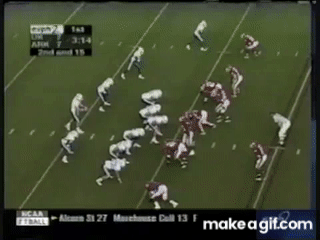
Here’s the same play in the 2020 State-LSU game:
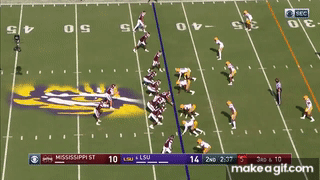
To attack the defense horizontally and test its ability to tackle in space, Leach will call for a flat concept:
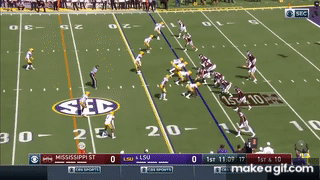
Screens are a hallmark of the Air Raid. Screens are most often used to beat zone defenses, especially zone blitzes, but the Air Raid uses a tunnel screen to spring a quick receiver against man coverage:

All of this puts tremendous pressure on the defense to make tackles in space.
If the defense creeps up too far, then Leach can call in a classic: four verticals.
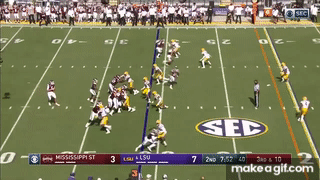
Okay, so how do you defend this?
In 2020, Arkansas pulled off what is arguably the best way: rushing three, dropping eight, and forcing State to make contested throws into tight windows. The Hogs repeatedly got off the field on third-and-long by keeping everything in front. Watch how the Razorbacks don’t even defend the underneath Mesh since it is short of the sticks:
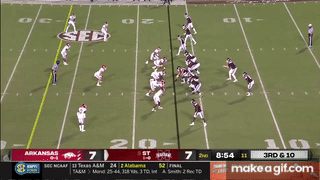
Key to this strategy – as you can see in the gif above – is that Arkansas routinely got pressure with a three-man rush. Jonathan Marshall was a monster that day.
Of course, Arkansas tried the same thing in 2021 and ended up allowing 417 passing yards. That was a against a better quarterback (Will Rogers) and without Jalen Catalon, but that’s the situation again this year. The only real advantage that this Arkansas team has is the pass rush: if the Hogs can get decent pressure while rushing three (or bringing Drew Sanders to make four) then they might can kill drives with a few havoc plays. That’s what they’ve been trying to do ever since Catalon got hurt, and it hasn’t worked, but it’s probably the only way.
Safety play is what would prevent this strategy from working, and it looks like Odom is making moves to fix that this week:
This makes sense, as Malik Chavis has settled in at the other cornerback spot. Clark – a veteran of that 2020 game – is smart and experienced, so putting him on the bench makes no sense given the issues at safety. There’s a good chance we see Clark starting as the third safety along with Latavious Brini and Simeon Blair, with Jayden Johnson and Khari Johnson also getting some snaps. If Myles Slusher is in fact out, that would be more devastating news, and Trent Gordon or JJ would likely replace him.
Keys to the Game
Force some turnovers. This was a key last week and the Hogs managed only to push, with each team turning it over once. One more Alabama turnover in the fourth quarter and this could have been totally different ballgame. State is more turnover-prone than the Tide, so the urgency is increased. The Hogs’ defense can give itself a chance by forcing two or three turnovers.
Find the big play. The Hog offensive line leaned on Alabama for a while there in the third quarter, but the big plays still didn’t come. This week, they have to. The Hogs are unlikely to generate enough offense to win the game without some big plays. State is vulnerable to big plays in both the run and pass games, so the chances will be there. Even if Cade Fortin starts, he’s capable of making the big plays happen. One way or another, they have to come.
Get off the field on third-and-long. This is a lot easier said than done, but Arkansas cannot remain this bad on third-and-long. That 3rd-and-15 backbreaker against Alabama essentially ended the game. The Tide converted 3 of 5 third-and-7+ situations, including that one. The Hogs will likely force the Bulldogs into several third-and-longs, but State drives have to end there.
Thanks for reading! Be sure to follow us on Twitter.
The latest from Fayette Villains, straight to your inbox
Enter your email to subscribe and receive new post alerts and other updates. You can unsubscribe at any time.